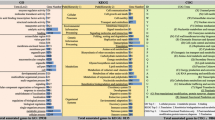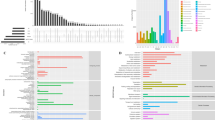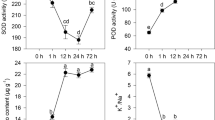Abstract
Key message
Multiple regulatory pathways of T. chinensis to salt stress were identified through transcriptome data analysis.
Abstract
Tamarix chinensis (Tamarix chinensis Lour.) is a typical halophyte capable of completing its life cycle in soils with medium to high salinity. However, the mechanisms underlying its resistance to high salt stress are still largely unclear. In this study, transcriptome profiling analyses in different organs of T. chinensis plants in response to salt stress were carried out. A total number of 2280, 689, and 489 differentially expressed genes (DEGs) were, respectively, identified in roots, stems, and leaves, with more DEGs detected in roots than in stems and leaves. Gene Ontology (GO) term analysis revealed that they were significantly enriched in “biological processes” and “molecular functions”. Kyoto Encyclopedia of Genes and Genomes (KEGG) pathway analysis revealed that “Beta-alanine metabolism” was the most differentially enriched pathway in roots, stems, and leaves. In pair-to-pair comparison of the most differentially enriched pathways, a total of 14 pathways, including 5 pathways in roots and leaves, 6 pathways in roots and stems, and 3 pathways in leaves and stems, were identified. Furthermore, genes encoding transcription factor, such as bHLH, bZIP, HD-Zip, MYB, NAC, WRKY, and genes associated with oxidative stress, starch and sucrose metabolism, and ion homeostasis, were differentially expressed with distinct organ specificity in roots, stems, and leaves. Our findings in this research provide a novel approach for exploring the salt tolerance mechanism of halophytes and identifying new gene targets for the genetic breeding of new plant cultivars with improved resistance to salt stress.










Similar content being viewed by others
Data availability statement
The datasets presented in this study can be found at the website https://www.ncbi.nlm.nih.gov/bioproject/ with the accession number of PRJNA991128.
References
Amtmann A, Sanders D (1998) Mechanisms of Na+ uptake by plant cells. Adv Bot Res 29(8):75–112. https://doi.org/10.1016/S0065-2296(08)60310-9
Apel K, Hirt H (2004) Reactive oxygen species: metabolism, oxidative stress, and signal transduction. Annu Rev Plant Biol. https://doi.org/10.1146/annurev.arplant.55.031903.141701
Arai Y, Nishimura HM (2008) Proteomic identification and characterization of a novel peroxisomal adenine nucleotide transporter supplying ATP for fatty acid beta-oxidation in soybean and arabidopsis. Plant Cell. https://doi.org/10.1105/tpc.108.062877
Asada K (2006) Production and scavenging of reactive oxygen species in chloroplasts and their functions. Plant Physiol 141(2):391–396. https://doi.org/10.1104/pp.106.082040
Baillo EH, Kimotho RN, Zhang Zb XuP (2019) Transcription factors associated with abiotic and biotic stress tolerance and their potential for crops improvement. Genes-Basel. https://doi.org/10.3390/genes10100771
Baxter A, Mittler R, Suzuki N (2014) ROS as key players in plant stress signalling. J Exp Bot. https://doi.org/10.1093/jxb/ert375
Brosché M, Overmyer K, Wrzaczek M, Kangasjärvi J, Kangasjärvi S (2009) Stress signaling III: reactive oxygen species (ROS). Abiotic Stress Adapt Plants. https://doi.org/10.1007/978-90-481-3112-9_5
Chen FQ, Fang P, Zeng WJ, Ding YF, Zhuang ZL, Peng YL (2020) Comparing transcriptome expression profiles to reveal the mechanisms of salt tolerance and exogenous glycine betaine mitigation in maize seedlings. PLoS ONE 15(5):e0233616. https://doi.org/10.1371/journal
Chen YH, Wang GY, Zhang HX, Zhang N, Jiang J, Song ZZ (2022) Transcriptome analysis of Tamarix ramosissima leaves in response to NaCl stress. PLoS ONE 17(3):e0265653. https://doi.org/10.1371/journal.pone.0265653
Erpen L, Devi HS, Grosser JW, Dutt M (2018) Potential use of the DREB/ERF, MYB, NAC and WRKY transcription factors to improve abiotic and biotic stress in transgenic plants. Plant Cell Tissue Organ Cult (PCTOC). https://doi.org/10.1007/s11240-017-1320-6
Flowers TJ, Colmer TD (2008) Salinity tolerance in halophytes. New Phytol 179:945–963. https://doi.org/10.1111/j.1469-8137.2008.02531.x
Flowers TJ, Munns R, Colmer TD (2015) Sodium chloride toxicity and the cellular basis of salt tolerance in halophytes. Ann Bot-London 115:419–431. https://doi.org/10.1093/aob/mcu217
Foulon V, Antonenkov VD, Croes K, Waelkens E, Mannaerts GP, Van Veldhoven PP, Casteels M (1999) Purification, molecular cloning, and expression of 2-hydroxyphytanoyl-CoA lyase, a peroxisomal thiamine pyrophosphate dependent enzyme that catalyzes the carbon-carbon bond cleavage during alpha -oxidation of 3-Methyl-Branched fatty acids. Proc Natl Acad Sci 96(18):10039–10044. https://doi.org/10.1073/pnas.96.18.10039
Gaskin JF (2003) Flowering plants. Dicotyledons. https://doi.org/10.1111/j.1469-8137.2008.02531.x
Ghanem AFM, Mohamed E, Kasem AMMA, El-Ghamery AA (2021) Differential salt tolerance strategies in three halophytes from the same ecological habitat: augmentation of antioxidant enzymes and compounds. Plants 10:1100. https://doi.org/10.3390/plants10061100
Guo R, Zhao L, Zhang K, Lu H, Bhanbhro N, Yang C (2021) Comparative genomics and transcriptomics of the extreme halophyte puccinellia tenuiflora provides insights into salinity tolerance differentiation between halophytes and glycophytes. Front Plant Sci 12:649001. https://doi.org/10.3389/fpls.2021.649001
Hussain T, Li J, Feng X, Asrar H, Gul B, Liu X (2021) Salinity induced alterations in photosynthetic and oxidative regulation are ameliorated as a function of salt secretion. J Plant Res 134(4):779–796. https://doi.org/10.1007/s10265-021-01285-5
Jabnoune M, Espeout S, Mieulet D, Fizames C, Verdeil JL, Conéjéro G, Rodríguez-Navarro A, Sentenac H, Guiderdoni E, Abdelly C, Véry AA (2009) Diversity in expression patterns and functional properties in the rice HKT transporter family. Plant Physiol 150:1955–1971. https://doi.org/10.1104/pp.109.138008
Jiang D, Xia M, Xing H, Gong M, Jiang Y, Liu H, Li HL (2023) Exploring the heat shock transcription factor (HSF) gene family in ginger: a genome-wide investigation on evolution, expression profiling, and response to developmental and abiotic stresses. Plants (basel) 12(16):2999. https://doi.org/10.3390/plants12162999
Jin JP, Tian F, Yang DC, Meng YQ, Kong L, Luo JC, Gao G (2017) PlantTFDB 4.0: toward a central hub for transcription factors and regulatory interactions in plants. Nucleic Acids Res 45:D1040–D1045. https://doi.org/10.1093/nar/gkw1328
Kiani-Pouya A, Roessner U, Jayasinghe NS, Lutz A, Rupasinghe T, Bazihizina N, Bohm J, Alharbi S, Hedrich R, Shabala S (2017) Epidermal bladder cells confer salinity stress tolerance in the halophyte quinoa and atriplex species. Plant Cell Environ 40:1900–1915. https://doi.org/10.1111/pce.12995
Krasensky J, Jonak C (2012) Drought, salt, and temperature stress-induced metabolic rearrangements and regulatory networks. (special issue: organellar signalling.). J Exp Bot. https://doi.org/10.1093/jxb/err460
Lai Y, Zhang D, Wang J, Wang J, Wang H (2020) Integrative transcriptomic and proteomic analyses of molecular mechanism responding to salt stress during seed germination in hulless barley. Int J Mol Sci 21(1):359. https://doi.org/10.3390/ijms21010359
Li H, Gao Y, Xu H, Dai Y, Deng D, Chen J (2013) Zmwrky33, a wrky maize transcription factor conferring enhanced salt stress tolerances in arabidopsis. Plant Growth Regul 70(3):207–216. https://doi.org/10.1007/s10725-013-9792-9
Li Y, Zhang L, Zhu P, Cao Q, Sun J, Li ZY, Xu T (2019) Genome-wide identification, characterisation and functional evaluation of WRKY genes in the sweet potato wild ancestor ipomoea trifida (h.b.k.) g. don. under abiotic stresses. BMC Genet. https://doi.org/10.1186/s12863-019-0789-x
Li CS, Qi YT, Zhao CZ, Wang XJ, Zhang Q (2021) Transcriptome profiling of the salt stress response in the leaves and roots of halophytic Eutrema salsugineum. Front Genet. https://doi.org/10.3389/fgene.2021.770742
Liu C, Mao B, Yuan D, Chu C, Duan M (2022) Salt tolerance in rice: physiological responses and molecular mechanisms. Crop 10:13–25. https://doi.org/10.1016/j.cj.2021.02.010
Ma XM, Liu JN, Yan LP, Liang Q, Fang HC, Wang CX, Dong YH, Chai ZJ, Zhou R, Bao Y, Hou WR, Yang KQ, Wu DJ (2022) Comparative transcriptome analysis unravels defense pathways of Fraxinus velutina torr against salt stress. Front Plant Sci 13:842726. https://doi.org/10.3389/fpls.2022.842726
Mohanta TK, Yadav D, Khan A, Hashem A, Tabassum B, Khan AL, Abd Allah EF, Al-Harrasi A (2020) Genomics, molecular and evolutionary perspective of NAC transcription factors. PLoS ONE 15(4):e0231425. https://doi.org/10.1371/journal.pone.0231425
Munns R (2005) Genes and salt tolerance: bringing them together. New Phytol 167(3):645–663. https://doi.org/10.1111/j.1469-8137.2005.01487.x
Munns R, Passioura J (1984) Hydraulic resistance of plants. III. Effects of NaCl in barley and lupin. Aust J Plant Physiol 11(5):351–359. https://doi.org/10.1071/PP9840351
Munns R, Tester M (2008) Mechanisms of salinity tolerance. Annu Rev Plant Biol 59(1):651–681. https://doi.org/10.1146/annurev.arplant.59.032607.092911
Ouertani RN, Arasappan D, Abid G, Ben Chikha M, Jardak R, Mahmoudi H, Mejri S, Ghorbel A, Ruhlman TA, Jansen RK (2021) Transcriptomic analysis of salt-stress-responsive genes in barley roots and leaves. Int J Mol Sci 22:8155. https://doi.org/10.3390/IJMS22158155
Pan L, Yu X, Shao J, Liu Z, Chen C (2019) Transcriptomic profiling and analysis of differentially expressed genes in asparagus bean (vigna unguiculata ssp. sesquipedalis) under salt stress. PLoS ONE 14(7):e0219799. https://doi.org/10.1371/journal.pone.0219799
Pang XA, Suo JT, Liu S, Xu JD, Yang TG, Xiang NY, Wu Y, Lu BJ, Qin R, Liu H, Yao JL (2022) Combined transcriptomic and metabolomic analysis reveals the potential mechanism of seed germination and young seedling growth in Tamarix hispida. BMC Genomics 23:109. https://doi.org/10.1186/s12864-022-08341-x
Parida AK, Das AB (2005) Salt tolerance and salinity effects on plants: a review. Ecotox Environ Safe 60(3):324–349. https://doi.org/10.1016/j.ecoenv.2004.06.010
Peng Z, He SP, Gong WF, Sun JL, Pan ZE, Xu FF, Lu YL, Du XM (2014) Comprehensive analysis of differentially expressed genes and transcriptional regulation induced by salt stress in two contrasting cotton genotypes. BMC Genomics 15(1):760. https://doi.org/10.1186/1471-2164-15-760
Peng Z, Rehman A, Li X, Jiang X, Tian C, Wang X, Li H, Wang Z, He S, Du X (2023) Comprehensive evaluation and transcriptome analysis reveal the salt tolerance mechanism in semi-wild cotton (Gossypium purpurascens). Int J Mol Sci 24(16):12853. https://doi.org/10.3390/ijms241612853
Qiu Z, Yuan M, He Y, Li Y, Zhang L (2017) Physiological and transcriptome analysis of He-Ne laser pretreated wheat seedlings in response to drought stress. Sci Rep 7(1):6108. https://doi.org/10.1038/s41598-017-06518-z
Rehman HM, Nawaz MA, Shah ZH, Daur I, Khatoon S, Yang SH, Chung G (2017) In-depth genomic and transcriptomic analysis of five K+ transporter gene families in soybean confirm their differential expression for nodulation. Front Plant Sci 23(8):804. https://doi.org/10.3389/fpls.2017.00804
Rozema J, Flowers T (2008) Crops for a salinized world. Science. https://doi.org/10.1126/science.1168572
Ruan YL (2014) Sucrose metabolism: gateway to diverse carbon use and sugar signaling. Annu Rev Plant Biol 65:33–67. https://doi.org/10.1146/annurev-arplant-050213-040251
Shi P, Gu M (2020) Transcriptome analysis and differential gene expression profiling of two contrasting quinoa genotypes in response to salt stress. BMC Plant Biol. https://doi.org/10.21203/rs.3.rs-35255/v1
Sun SY, Wang YP, Wang JW, Tan MM, Yan H, So K, Zhang YN (2023) Transcriptome responses to salt stress in roots and leaves of Lilium pumilum. Sci Hortic-Amsterdam 309:111622. https://doi.org/10.1016/J.SCIENTA.2022.111622
Thalmann M, Santelia D (2017) Starch as a determinant of plant fitness under abiotic stress. New Phytol 214(3):943–951. https://doi.org/10.1111/nph.14491
Tian F, Chang E, Li Y, Sun P, Hu J, Zhang J (2017) Expression and integrated network analyses revealed functional divergence of NHX-type Na+/H+ exchanger genes in poplar. Sci Rep 7(1):2607. https://doi.org/10.1038/s41598-017-02894-8
Van den Bosch H, Schutgens RBH, Wanders RJA, Tager JM (1992) Biochemistry of peroxisomes. Annu Rev Biochem 61(1):157–197. https://doi.org/10.1146/annurev.bi.61.070192.001105
van Zelm E, Zhang Y, Testerink C (2020) Salt tolerance mechanisms of plants. Annu Rev Plant Biol 29(71):403–433. https://doi.org/10.1146/annurev-arplant-050718-100005
Vandersande MW, Glenn EP, Walworth JL (2001) Tolerance of five riparian plants from the lower Colorado River to salinity drought and inundation. J Arid Environ 49(1):147–159. https://doi.org/10.1006/jare.2001.0839
Wanders R, Ferdinandusse S, Jansen GA, Grusven VEG, Waterham HR, Roermund VCWT, Vreken P (2001) Peroxisomal fatty acid alpha- and beta-oxidation in humans: new insights into enzymology, substrate specificities, metabolite transport and peroxisomal diseases. Biochem Soc Trans 29(1):A2.2-A2. https://doi.org/10.1042/bst029a002a
Wang BS, Zhao KF (1995) Comparison of extractive methods of Na+/K+ in wheat leaves. Plant Physiol 31:50–52. https://doi.org/10.13592/j.cnki.ppj.1995.01.020
Wang YH, Ying Y, Chen J, Wang XC (2004) Transgenic arabidopsis overexpressing Mn-SOD enhanced salt-tolerance. Plant Sci 167(4):671–677. https://doi.org/10.1016/j.plantsci.2004.03.032
Wang PL, Lei XJ, Wang YY, Liu BC, Wang DN, Liu ZY, Gao CQ (2022) Transcriptomic analysis of cadmium stressed Tamarix hispida revealed novel transcripts and the importance of abscisic acid network. Front Plant Sci. https://doi.org/10.3389/FPLS.2022.843725
Wi J, Na Y, Yang E, Lee JH, Choi DW (2020) Arabidopsis atmpv17, a homolog of mice mpv17, enhances osmotic stress tolerance. Physiol Mol Biol Pla 26(7):1341–1348. https://doi.org/10.1007/s12298-020-00834-x
Yan X, Chang Y, Zhao WJ, Qian CJ, Yin XY, Fan XK, Zhu XY, Zhao XQ, Ma XF (2022) Transcriptome profiling reveals that foliar water uptake occurs with c3 and crassulacean acid metabolism facultative photosynthesis in Tamarix ramosissima under extreme drought. AoB Plants. https://doi.org/10.1093/aobpla/plab060
Ye YJ, Wang JW, Wang W, Xu LA (2020) ARF family identification in Tamarix chinensis reveals the salt responsive expression of TcARF6 targeted by miR167. PeerJ 8:e8829. https://doi.org/10.7717/peerj.8829
Yokotani N, Hasegawa Y, Sato M, Hirakawa H, Kouzai Y, Nishizawa Y, Yamamoto E, Naito Y, Isobe S (2021) Transcriptome analysis of clavibacter michiganensis subsp. michiganensis-infected tomatoes: a role of salicylic acid in the host response. BMC Plant Biol 21(1):476. https://doi.org/10.1186/s12870-021-03251-8
Zhang X, Yao Y, Li X, Zhang L, Fan S (2020) Transcriptomic analysis identifies novel genes and pathways for salt stress responses in Suaeda salsa leaves. Sci Rep 10(1):4236. https://doi.org/10.1038/s41598-020-61204-x
Zhao C, Zhang H, Song C, Zhu JK, Shabala S (2020) Mechanisms of plant responses and adaptation to soil salinity. Innovation 1(1):100017. https://doi.org/10.1016/j.xinn.2020.100017
Zhu JK (2002) Salt and drought stress signal transduction in plants. Annu Rev Plant Biol 53(1):247. https://doi.org/10.1146/annurev.arplant.53.091401.143329
Zhu Q, Zhang J, Gao X, Tong J, Xiao L, Li W, Zhang H (2010) The Arabidopsis AP2/ERF transcription factor RAP2.6 participates in ABA, salt and osmotic stress responses. Gene 457(1–2):1–12. https://doi.org/10.1016/j.gene.2010.02.011
Zhu M, Meng X, Cai J, Li G, Dong T, Li Z (2018) Basic leucine zipper transcription factor SlbZIP1 mediates salt and drought stress tolerance in tomato. BMC Plant Biol 18(1):83. https://doi.org/10.1186/s12870-018-1299-0
Zhu Y, Yin J, Liang Y, Liu J, Jia J, Huo H, Wu Z, Yang R, Gong H (2019) Transcriptomic dynamics provide an insight into the mechanism for silicon-mediated alleviation of salt stress in cucumber plants. Ecotox Environ Safe 15(174):245–254. https://doi.org/10.1016/j.ecoenv.2019.02.075
Zou C, Liu D, Wu P, Wang Y, Gai Z, Liu L, Yang F, Li C, Guo G (2020) Transcriptome analysis of sugar beet (Beta vulgaris L) in response to alkaline stress. Plant Mol Biol 102(6):645–657. https://doi.org/10.1007/s11103-020-00971-
Funding
This work has been jointly supported by the following grants: the Natural Science Foundation of Shandong Province, China (ZR2020QC062); the Innovation Project of Shandong Academy of Agricultural Sciences, China (CXGC2022F06, CXGC2023A16, CXGC2023G07); the National Natural Science Foundation of China (41807083, 32071733, 31870576); the “Cocoon-break” Supporting Fund Project of Shandong Institute of Sericulture, China (FC202301).
Author information
Authors and Affiliations
Contributions
HZ and HZ conceived and designed the experiments; RL, RF, ML, YS, JL, CC, YG, XL, WN, LM, and XW performed the experiments and data analysis. HZ and HZ wrote and revised the manuscript. All authors have read and approved the paper.
Corresponding authors
Ethics declarations
Conflict of interest
The authors declare that they have no known competing financial interests or personal relationships that could have appeared to influence the work reported in this paper.
Additional information
Communicated by Chun-Hai Dong.
Publisher's Note
Springer Nature remains neutral with regard to jurisdictional claims in published maps and institutional affiliations.
Supplementary Information
Below is the link to the electronic supplementary material.
Rights and permissions
Springer Nature or its licensor (e.g. a society or other partner) holds exclusive rights to this article under a publishing agreement with the author(s) or other rightsholder(s); author self-archiving of the accepted manuscript version of this article is solely governed by the terms of such publishing agreement and applicable law.
About this article
Cite this article
Li, R., Fu, R., Li, M. et al. Transcriptome profiling reveals multiple regulatory pathways of Tamarix chinensis in response to salt stress. Plant Cell Rep 42, 1809–1824 (2023). https://doi.org/10.1007/s00299-023-03067-w
Received:
Accepted:
Published:
Issue Date:
DOI: https://doi.org/10.1007/s00299-023-03067-w




